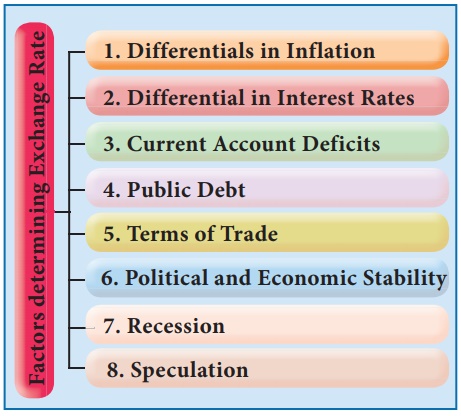International Economics - Exchange Rate | 12th Economics : Chapter 7 : International Economics
Chapter: 12th Economics : Chapter 7 : International Economics
Exchange Rate
Exchange Rate
1. Meaning of Foreign Exchange (FOREX)
FOREX refers to foreign currencies. The mechanism through which
payments are effected between two countries having different currency systems
is called FOREX system . It covers methods of payment, rules and regulations of
payment and the institutions facilitating such payments.
2. Definition of FOREX
“FOREX is the system or process of converting one national
currency into another, and of transferring money from one country to another”.
3. Rate of Exchange
The transactions in the exchange market are carried out at
exchange rates. It is the external value of domestic currency. Thus, exchange
rate may be defined as the price paid in the home currency (say ₹ 75) for a
unit of foreign currency (say 1 US $). It can be quoted in two ways:
1. One unit of foreign money (1 USD) to so many units of the
domestic currency (₹); or
2. A certain number of units of foreign currency (USD)to one unit
of domestic money (₹ 1)
For instance:
1 U.S Dollar = ₹ 70 , or
₹ 1 = U.S.1.42 cents

4. Definition of Equilibrium Exchange Rate
“The equilibrium exchange rate is that rate, which over a certain
period of time, keeps the balance of payments in equilibrium”.
- Ragner Nurkse
5. Determination of Equilibrium Exchange Rate
The equilibrium rate of exchange is determined in the foreign
exchange market in accordance with the general theory of value, i.e., by the
interaction of the forces of demand and supply. Thus, the rate of exchange is
determined at the point where demand for forex is equal to the supply of forex.

In the above diagram, Y axis represents exchange rate, that is,
value of rupee in terms of dollars. X axis represents demand and supply of
forex. E is the point of equilibrium where DD intersects SS. The exchange rate
is P2.
6. Types of Exchange Rate Systems
Broadly, there are two major exchange rate systems, namely, (1)
fixed (or pegged) exchange rate system and flexible (or floating) exchange rate
system. Managed Floating Exchange Rate system also prevails in some countries
(like India).
1. Fixed Exchange Rates
Countries following the fixed exchange rate (also known as stable
exchange rate and pegged exchange rate) system agree to keep their currencies
at a fixed rate as determined by the Government. Under the gold standard, the
value of currencies was fixed in terms of gold.
2. Flexible Exchange Rates
Under the flexible exchange rate (also known as floating exchange
rate) system, exchange rates are freely determined in an open market by market
forces of demand and supply.
7. Types of Exchange Rates
Exchange rates are also in the form of (a) Nominal exchange rate
(b) Real exchange rate (c) Nominal Effective Exchange Rate (NEER) and (d) Real
Effective Exchange Rate (REER)
If 1 US Dollar = ₹ 75,
Nominal exchange rate = 75/1 = 75.
This is the bilateral nominal exchange rate.
Real Exchange rate = ePf/P

P = Price levels in India
Pf = Price levels in abroad (say US)
e = nominal exchange rate.
If a pen costs ₹ 50 in India and it costs 5 USD in the US,
Real Exchange Rate = 75x5 / 50 = 7.5
If real exchange rate is equal to 1, the currencies are at
purchasing power parity.
It the price of the pen in US is 0.66 USD then the real exchange
rate = 66x75 / 50 € then it could be said that the USD and Indian rupee
are at purchasing power parity.
NEER and REER are not explained here.
Interested students and teachers can search for them.
8. Determinants of Exchange Rates
Exchange rates are determined by numerous factors and they are
related to the trading relationship between two countries.

1. Differentials in Inflation
Inflation and exchange rates are inversely related. A country with
a consistently lower inflation rate exhibits a rising currency value, as its
purchasing power increases relative to other currencies.
2. Differentials in Interest Rates
There is a high degree of correlation between interest rates,
inflation and exchange rates. Central banks can influence over both inflation
and exchange rates by manipulating interest rates. Higher interest rates
attract foreign capital and cause the exchange rate to rise and vice versa.
3. Current Account Deficits
A deficit in the current account implies excess of payments over
receipts. The country resorts to borrowing capital from foreign sources to make
up the deficit. Excess demand for foreign currency lowers a country’s exchange
rate.
4. Public Debt
Large public debts are driving out foreign investors, because it
leads to inflation. As a result, exchange rate will be lower.
5. Terms of Trade
A country’s terms of trade also determines the exchange rate. If
the price of a country’s exports rises by a greater rate than that of its
imports, its terms of trade will improve. Favorable terms of trade imply
greater demand for the country’s exports and thus BoP becomes favorable.
6. Political and Economic Stability
If a nation’s political climate is stable and economic performance
is good, its currency value will be appreciated by attracting more foreign
capital.
7. Recession
Interest rates are low during the recession phase. This will
decrease inflow of foreign capital. As a result, a currency will be depreciated
against other currencies, thereby lowering the exchange rate.
8. Speculation
If a country’s currency value is expected to rise, investors will
demand more of that currency in order to make a profit in the near future. This
results in appreciation of the exchange rate. Beside the above determinants,
relative dominance in the global politics and the power to announce economic sanctions
over other countries also determine exchange rates.
Related Topics